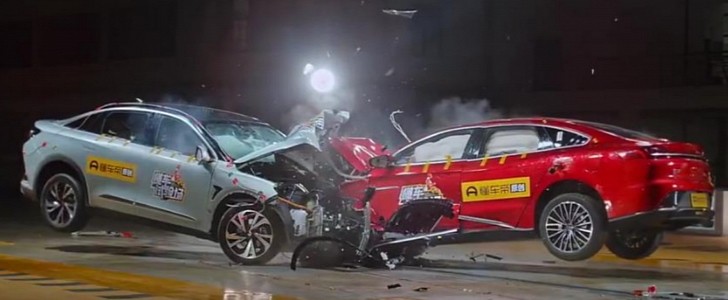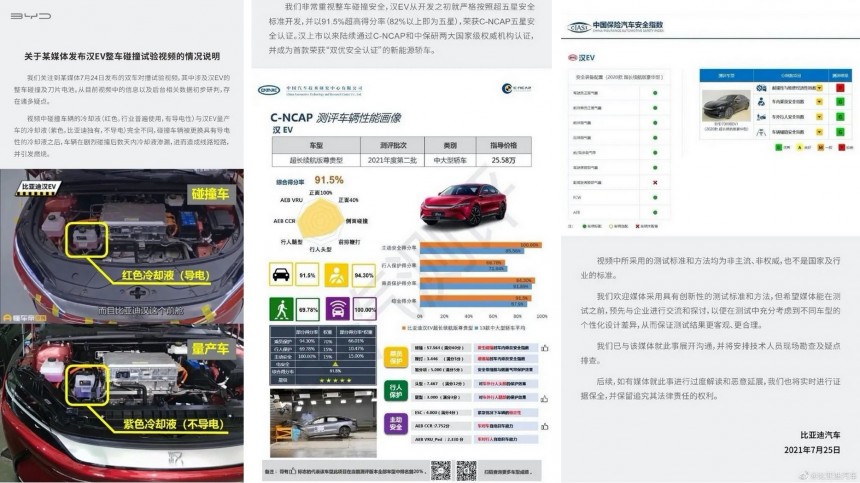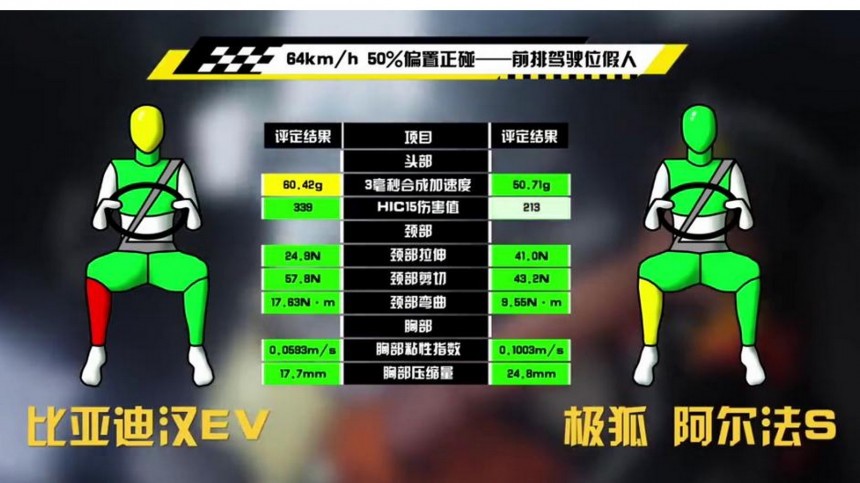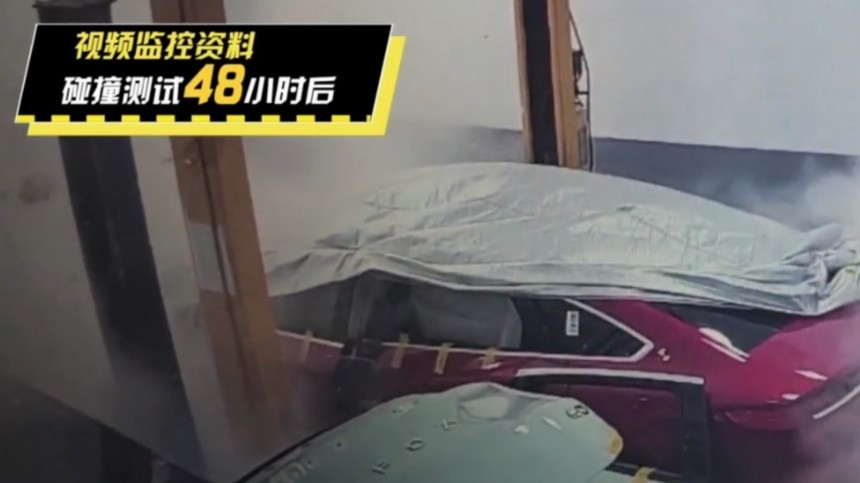BYD was pretty proud of the Han and its Blade Battery technology until July 24. On that day, the show “Understanding the Car Test Ground” put the electric BYD against the ArcFox αS in a frontal offset crash test. Each vehicle was to travel at 64 kph (40 mph). More than the results, the aftermath is what called people’s attention: the Han caught fire 48 hours after the test.
That’s quite an unexpected thing to happen with the Han and its Blade Battery pack. Composed of LFP (lithium iron phosphate) cells, it was supposed to be very resistant to such events. Yet, the images made by the show prove it is not exempt from these episodes.
BYD released an official explanation on WeChat stating that the crash test brought up “many doubts.” One of them would be related to the coolant that can be seen in the Han. It was red, which indicated that it would be a conductive coolant used by the rest of the industry, but not by BYD. The company said that coolant is a possible cause for the blaze.
Without directly pointing its finger against “Understanding the Car Test Ground,” BYD said the original one would have been replaced. According to the company, the Han should have a purple, non-conductive coolant instead.
The issue with that allegation is that Han owners in China got curious. Some decided to check the color of the coolant in their cars and claimed on social media that it was also red. Since they said they never replaced it, the red coolant would have come from the factory.
We got in touch with BYD to check that, and the company just told us that “every new vehicle delivered by BYD has been tested strictly, and guarantee the excellent performance of fluid in the original car to fully meet the normal driving needs.” That does not answer our questions, so we reinforced our doubts and are waiting for the replies.
If BYD put the red coolant in its EVs, as some owners claim, will it recall them to replace the coolant for the right one? If it denies it used the wrong coolant in the Han, who did that? “Understanding the Car Test Ground” already replied and said it made no changes to the Han in the crash test. It also said it followed all due procedures.
In the test, the ArcFox αS performed slightly better than the Han. The driver’s door could still open, but the front airbags did not deploy. The rear passengers would also suffer severe damages because the seat belts did not hold them in place as they should.
The Han presented a deformed roof and cabin that prevented the driver’s door from opening. That possibly happened because the battery pack partially separated from the body. The cabin deformation would make the driver hurt his head and have severe injuries to his right leg. The rear passenger would be as seriously hurt as the one in the ArcFox αS.
BYD’s excuse for the poor performance was that the car was conceived to get five stars in the C-NCAP and did pretty well there. It also said the test standards were “all non-mainstream, non-authoritative, and not national and industry standards.” BYD also threatened to sue “media over-interpretation and malicious extension of this matter.”
BYD probably refers to the speed at which the vehicles crash. Euro NCAP used to put them to 64 km/h against a deformable barrier to simulate a collision of two vehicles traveling at 50 km/h in opposite directions. Now, Euro NCAP accelerates the test car and a mobile progressive deformable barrier of 1,400 kg (3,087 lb) to 50 km/h each. In other words, they crash at a slower speed than that used by “Understanding the Car Test Ground.”
Vehicles are designed to meet specific safety targets. If they are raised, the chance that they will not perform well increased. Anyway, meeting these safety targets sometimes is not enough.
Ford and GM gave an excellent example of that when Latin NCAP revealed that the Ford Ka and Chevrolet Onix sold in South America did not offer adequate protection to occupants in crashes. Both lacked essential equipment such as side-impact door beams. Ford and GM said that their cars complied with the outdated South American legal demands for car safety. Although that was true, it was not a disappointing excuse.
Until we have a global safety standard for cars, we’ll see more and more situations in which modern cars perform poorly. In BYD’s case, the test may have been unfair until we learn how other vehicles fared in them. If they do better, BYD will have to find better arguments to defend the safety its flagship currently offers.
BYD released an official explanation on WeChat stating that the crash test brought up “many doubts.” One of them would be related to the coolant that can be seen in the Han. It was red, which indicated that it would be a conductive coolant used by the rest of the industry, but not by BYD. The company said that coolant is a possible cause for the blaze.
Without directly pointing its finger against “Understanding the Car Test Ground,” BYD said the original one would have been replaced. According to the company, the Han should have a purple, non-conductive coolant instead.
We got in touch with BYD to check that, and the company just told us that “every new vehicle delivered by BYD has been tested strictly, and guarantee the excellent performance of fluid in the original car to fully meet the normal driving needs.” That does not answer our questions, so we reinforced our doubts and are waiting for the replies.
If BYD put the red coolant in its EVs, as some owners claim, will it recall them to replace the coolant for the right one? If it denies it used the wrong coolant in the Han, who did that? “Understanding the Car Test Ground” already replied and said it made no changes to the Han in the crash test. It also said it followed all due procedures.
The Han presented a deformed roof and cabin that prevented the driver’s door from opening. That possibly happened because the battery pack partially separated from the body. The cabin deformation would make the driver hurt his head and have severe injuries to his right leg. The rear passenger would be as seriously hurt as the one in the ArcFox αS.
BYD’s excuse for the poor performance was that the car was conceived to get five stars in the C-NCAP and did pretty well there. It also said the test standards were “all non-mainstream, non-authoritative, and not national and industry standards.” BYD also threatened to sue “media over-interpretation and malicious extension of this matter.”
Vehicles are designed to meet specific safety targets. If they are raised, the chance that they will not perform well increased. Anyway, meeting these safety targets sometimes is not enough.
Ford and GM gave an excellent example of that when Latin NCAP revealed that the Ford Ka and Chevrolet Onix sold in South America did not offer adequate protection to occupants in crashes. Both lacked essential equipment such as side-impact door beams. Ford and GM said that their cars complied with the outdated South American legal demands for car safety. Although that was true, it was not a disappointing excuse.
Until we have a global safety standard for cars, we’ll see more and more situations in which modern cars perform poorly. In BYD’s case, the test may have been unfair until we learn how other vehicles fared in them. If they do better, BYD will have to find better arguments to defend the safety its flagship currently offers.

















